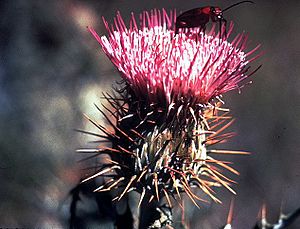Yellowspine thistle facts for kids
Quick facts for kids Yellowspine thistle |
|
|---|---|
 |
|
| Scientific classification | |
| Genus: |
Cirsium
|
| Species: |
ochrocentrum
|
| Synonyms | |
|
|
Cirsium ochrocentrum is a type of thistle often called the yellowspine thistle. It grows naturally in the Great Plains of the Central United States. You can also find it in the desert areas of the western United States and northern Mexico. Its home stretches from eastern Oregon all the way to the Black Hills in South Dakota. It also grows south into the Mexican State of Durango.
Contents
What Does the Yellowspine Thistle Look Like?
This plant is a perennial herb, which means it lives for more than two years. It can grow up to 1 metre (3.3 ft) tall. Each plant can have one to twenty stems, which are covered in soft, white, woolly hairs.
The leaves of the yellowspine thistle are usually deeply cut. These cuts form sharp, pointed teeth. The longest leaves are found at the bottom of the plant. They can be about 25 centimeters (10 inches) long. The leaves also have sharp spines, which can be up to 1.5 centimeters long.
The plant's inflorescence (which is how the flowers are arranged) has several flower heads. Each flower head is surrounded by tough, spiny leaves called phyllaries. Inside these heads, you'll find white, pink, or lavender colored disc florets. These are the small, tube-shaped flowers in the center of the head. This thistle does not have ray florets, which are the petal-like flowers you see on the outside of a daisy.
After the flowers bloom, the plant produces a fruit called an achene. This fruit has a brown body that is almost a centimeter long. On top of the achene is a feathery structure called a pappus. This pappus can be up to 3 centimeters long and helps the seeds float away in the wind.
Different Types of Yellowspine Thistle
There are a couple of known types, or varieties, of this plant:
- Cirsium ochrocentrum var. martinii – Found in Mexico, Arizona, and New Mexico.
- Cirsium ochrocentrum var. ochrocentrum – Found in the United States.
How People Use This Plant
The Zuni people, a Native American tribe, have traditionally used this plant. They would make a special tea, called an infusion, from the whole plant. This tea was used to help people sweat (a diaphoretic) or to help them urinate more (a diuretic). They also made a tea from the fresh or dried root. This root tea was taken three times a day for diabetes.
Sometimes, this plant is considered a noxious weed in places like California and Northwestern Mexico. This means it can grow in unwanted places. You might see it in fields or along roadsides, especially in areas that have been disturbed.
Images for kids
See also
In Spanish: Cirsium ochrocentrum para niños


